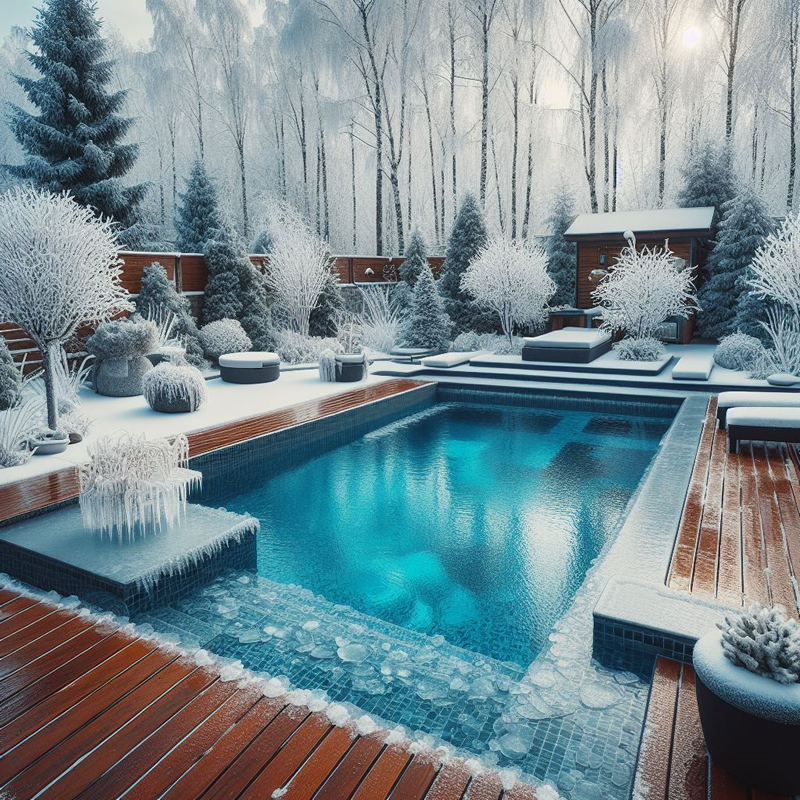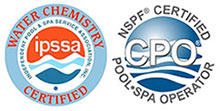When autumn leaves start falling and temperatures begin to drop, many pool owners make a costly mistake: they simply throw a cover over their pool and call it winterized. Unfortunately, this “set it and forget it” approach often leads to expensive surprises come spring – cracked equipment, algae blooms, damaged plaster, or worse, costly plumbing repairs that could have been easily prevented.
Proper pool winterization isn’t just about protecting your investment during the cold months; it’s about ensuring your pool opens smoothly and safely when swimming season returns. Whether you’re a hands-on homeowner or prefer to leave it to the professionals, understanding the winterization process helps you make informed decisions about your pool’s care.
At Pinnacle Pool & Spa Services, we’ve been helping homeowners throughout the Sacramento area to the Bay Area protect their pools for over 15 years. From El Dorado Hills to Walnut Creek, we’ve seen firsthand what happens when winterization is done right – and unfortunately, when it’s done wrong. This guide combines our professional insights with practical advice to help you understand what proper winterization entails.
Why Proper Winterization Matters
The difference between a pool that’s properly winterized and one that’s simply covered can cost thousands of dollars. During winter months, your pool faces unique challenges that don’t exist during swimming season. Freezing temperatures can crack pipes, damage pump housings, and destroy expensive equipment. Even in milder Bay Area climates, neglected pools develop chemical imbalances that promote algae growth and surface staining.
Consider the hidden costs of inadequate winterization: a cracked pool heater can cost $3,000-$5,000 to replace, while burst plumbing lines often require expensive excavation and repair. Algae blooms that develop over winter don’t just disappear with warmer weather – they require extensive chemical treatment and sometimes even pool draining and acid washing.
Winter also amplifies existing problems. A small leak that loses an inch of water per week during summer becomes a major issue when combined with winter rains and potential freeze damage.
“I was losing so much water and having to add a lot of water every day. Cooper was able to come out quickly and inspect my pool, he performed pressure tests to check the plumbing and also did a dye test throughout the pool, he ended up finding and repairing multiple leaks at a reasonable price.”
— Sofia Ramos, Arden-Arcade
The key insight from our years of experience? Prevention costs significantly less than repair. A professional winterization service typically costs a fraction of what you’ll spend fixing winter damage. More importantly, proper winterization means your pool is ready to enjoy when warm weather returns, not sitting unusable while you wait for repairs.
Pre-Winterization Inspection: The Foundation of Protection
Before any winterization work begins, a thorough inspection reveals potential problems that could become disasters during winter months. This critical first step often determines whether you’ll have a smooth spring opening or costly emergency repairs.
Equipment Assessment Your pool’s mechanical systems need careful evaluation before winter. Pool pumps, the heart of your circulation system, should be inspected for leaks, unusual noises, or signs of wear. A pump that’s struggling during warm weather will likely fail completely when stressed by cold temperatures. Heaters require special attention – gas heaters need proper venting checks, while electric heaters need electrical connection inspections.
Filter systems also deserve scrutiny. A cartridge filter that’s been marginally effective all season won’t suddenly improve over winter. Sand and DE filters need backwashing and media evaluation. Automation systems should be tested to ensure they’ll function reliably when you can’t check them daily.
The Critical Importance of Leak Detection Winter makes small leaks exponentially worse.
“Had a leak in my pool and needed leak detection and repair. Several of the companies I contacted via Yelp said they don’t do leak detection. Fortunately for me I found Pinnacle Pools and Cooper came out and found the leak and then scheduled a repair. The repair was done quickly and the price was less than those quoted by other companies.”
— Norman J., Fairfield
Even minor leaks can cause major problems when freezing temperatures hit exposed plumbing. Water that seeps into soil around your pool can freeze and expand, potentially damaging the pool shell or surrounding structures. Additionally, a leaking pool during winter storms can create drainage issues in your yard.
DIY vs. Professional Assessment While homeowners can check obvious issues like visible cracks, loose tiles, or obviously damaged equipment, many problems require professional expertise to identify. Subtle pump bearing wear, hairline cracks in equipment housings, or slow plumbing leaks often go unnoticed until they become expensive failures.
Pro Tip: If your pool has lost more than ¼ inch of water per day over the past month, schedule professional leak detection before winterization. What seems like normal evaporation might be a leak waiting to become a winter disaster.
Ready to ensure your pool is properly protected this winter? Contact Pinnacle Pool & Spa Services for a comprehensive pre-winterization inspection. Sacramento Area: (916) 530-2096 | Bay Area: (925) 849-6545
Step-by-Step Winterization Process
Water Chemistry Balance: The Chemical Foundation
Proper water chemistry during winterization prevents algae growth, surface staining, and equipment corrosion throughout the winter months. Unlike summer maintenance, winterization chemistry focuses on long-term stability rather than daily swimming comfort.
pH and Alkalinity Targets Aim for a pH between 7.2-7.6 and total alkalinity between 80-120 ppm before winterization. These levels provide a stable chemical environment that resists dramatic changes during winter. High pH can cause scaling on surfaces and equipment, while low pH becomes corrosive over time.
Shock Treatment Timing Apply a chlorine shock treatment 24-48 hours before final winterization. This eliminates any bacteria or algae spores that could multiply during the dormant period. Use 1-2 pounds of calcium hypochlorite per 10,000 gallons, ensuring complete dissolution and circulation before proceeding.
Algaecide Application Add a quality winter algaecide according to manufacturer instructions. Copper-based algaecides provide long-lasting protection but require careful application to prevent staining. Polymer-based alternatives are safer for all surface types and equally effective when properly applied.
Equipment Preparation: Protecting Your Investment
Pump and Filter Winterization Your circulation system requires the most careful attention during winterization. Begin by thoroughly cleaning your filter media – backwash sand or DE filters, or replace cartridge filters entirely. Clean filters prevent organic buildup that can cause problems during spring startup.
For areas where freezing is possible, pumps must be completely drained. Remove drain plugs from the pump housing, allowing all water to evacuate. Store these plugs in the pump basket so they’re not lost. If your pump has a built-in time clock, consider having it serviced before winter to prevent spring startup issues.
Heater Winterization Considerations Pool heaters require specific winterization procedures depending on their type. Gas heaters need complete water drainage from heat exchangers and proper gas line shut-off. Electric heaters require electrical disconnection and complete water drainage. Heat pumps, increasingly popular in milder climates, have specific manufacturer requirements for winter shutdown.
“Cooper recently replaced my pool heater and I can’t thank him enough. He quoted me a super reasonable price and although it ended up being more work, he never mentioned any additional charges. Despite the install being a bit of a pain, he didn’t cut any corners and really did nice work.”
— Matt Johnson, Pleasant Hill
Plumbing Line Drainage This critical step prevents the most expensive winter damage. All plumbing lines must be blown clear of water using compressed air. Return lines, skimmer lines, and main drains each require individual attention. Pool-grade antifreeze should be added to any lines that cannot be completely drained.
Pro Tip: Never use automotive antifreeze in pool plumbing. Only use propylene glycol-based antifreeze specifically designed for pools and spas.
Deep Cleaning and Debris Management
Comprehensive Pool Cleaning A thorough cleaning before winterization prevents organic matter from decomposing in your pool over winter. Brush all surfaces, paying special attention to areas with poor circulation. Vacuum all debris from the pool floor, including leaves, dirt, and any organic matter that could feed algae growth.
Clean the waterline tile thoroughly, removing any buildup that could become permanent during winter. Use appropriate tile cleaners for your specific tile type, ensuring complete removal of oils, dirt, and calcium deposits.
Skimmer and Drain Considerations Lower your water level to approximately 4-6 inches below the skimmer opening. This prevents ice damage to the skimmer throat while maintaining enough water to protect the pool surface. Remove skimmer baskets and weir doors, storing them in a dry location.
For pools with main drains, ensure they remain covered and functional. A properly operating main drain helps prevent ice formation on the pool bottom in extremely cold weather.
Pool Cover Selection and Installation
Safety Covers vs. Winter Covers Safety covers provide superior protection and can support significant weight, making them ideal for pools with children or pets nearby. These mesh or solid covers attach to anchors around the pool perimeter and completely eliminate access to the water.
Traditional winter covers cost less initially but require more maintenance and provide less security. These covers typically attach with water bags or cover clips and focus primarily on keeping debris out of the pool.
Professional Installation Benefits Proper cover installation significantly impacts its effectiveness and longevity. Professional installation ensures proper fit, adequate support, and correct attachment methods that prevent wind damage or cover failure.
“Best and most knowledgeable pool person that I’ve ever had work on my pool. He fixed my pump and fixed a leak in the pool. Fast, efficient and affordable.”
— Steve N., Loomis
When to Call a Professional: If your pool has unusual shapes, multiple levels, or spa attachments, professional cover installation ensures proper fit and protection.
Maintenance During Winter Months
Monthly Check Recommendations
Even properly winterized pools need periodic attention during winter months. Monthly inspections help catch problems before they become expensive disasters. Check cover condition, looking for tears, sagging, or loose attachments. Remove debris accumulation that could stress the cover or fall into the pool.
Inspect visible equipment for signs of damage from weather or pests. Look for loose connections, cracked housings, or signs of water where it shouldn’t be. Check pool water levels if visible, noting any significant changes that might indicate leaks.
When to Call Professionals
Certain winter situations require immediate professional attention. If your cover fails during a storm, prompt action prevents contamination and potential freeze damage. If you notice equipment damage or significant water loss, don’t wait until spring – winter conditions can make problems exponentially worse.
Power outages that affect pool equipment for extended periods may require professional assessment, especially if freezing temperatures follow. Automation systems that control critical functions should be checked after any power disruption.
“Our pool pump was only working intermittently. Cooper was able to come out quickly and take a look, he got us back on track in no time. Super fast and friendly service. Extremely knowledgeable and very professional.”
— Jennifer C., Shingle Springs
Storm Preparation
Winter storms bring unique challenges to pool owners. Before severe weather, ensure your cover is properly secured and remove any nearby objects that could blow into the pool area. After storms, inspect covers for damage and remove debris accumulation promptly.
Heavy snow loads can damage covers not designed for such weight. If significant snow accumulates, carefully remove excess weight using a soft broom or specialized cover pump, avoiding tears or stretching.
Pro Tip: Never walk on a pool cover to remove snow or debris. Even safety covers can be damaged by concentrated weight loads, and the risk of falling through into the pool is significant.
Protecting Your Pool Investment This Winter
Proper pool winterization represents an investment in your pool’s longevity and your family’s enjoyment. The few hundred dollars spent on professional winterization services pale in comparison to the thousands potentially lost to winter damage. More importantly, a properly winterized pool opens smoothly in spring, ready for immediate enjoyment rather than weeks of repairs and treatments.
Whether you choose to handle winterization yourself or hire professionals, understanding the process helps ensure nothing gets overlooked. The difference between adequate and excellent winterization often lies in the details – proper chemical balancing, complete equipment drainage, and quality cover installation.
At Pinnacle Pool & Spa Services, we’ve built our reputation on attention to these details. Serving the greater Sacramento area to the Bay Area, including Walnut Creek, Orinda, El Dorado Hills, Granite Bay, and the Highway 50 corridor down to the 680 corridor, we understand the unique challenges each region presents.
Don’t let winter damage turn your pool investment into an expensive problem. Contact the experienced professionals at Pinnacle Pool & Spa Services for comprehensive winterization services that protect your pool and ensure a trouble-free spring opening.
Sacramento Area: (916) 530-2096 | Bay Area: (925) 849-6545 | Toll Free: (888) 994-7665 (POOL)
Professional pool winterization and maintenance services for residential and commercial properties throughout Northern California.



